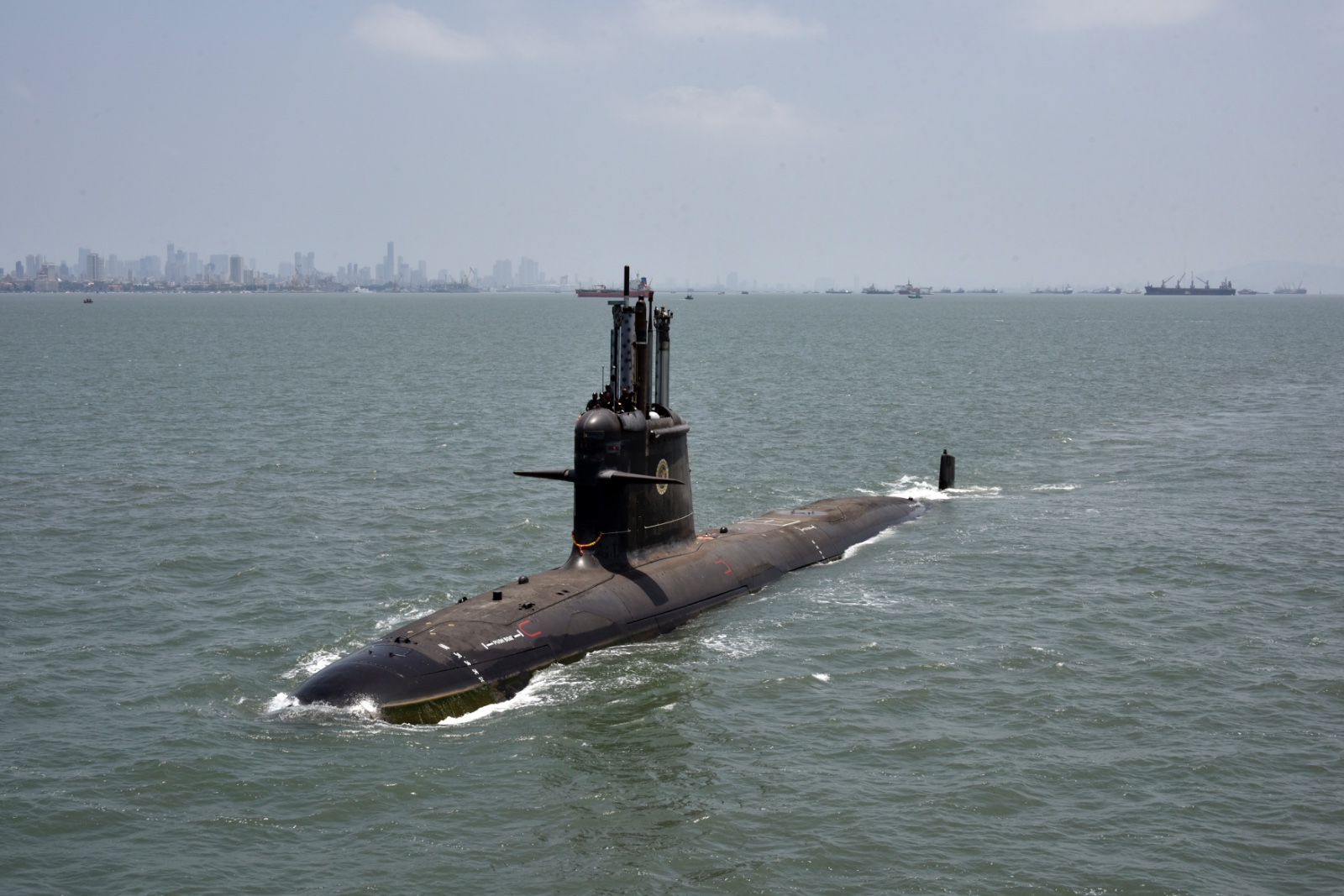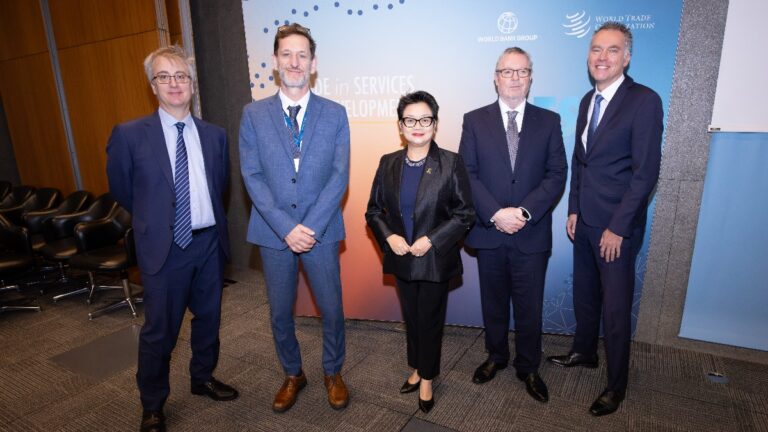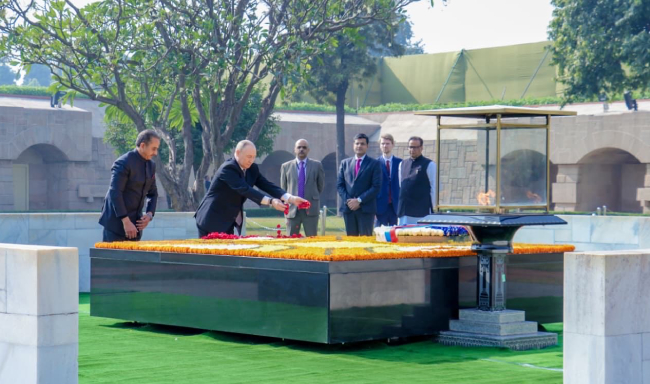
INS Vaghsheer
New Delhi: While the Ministry of Defence (MoD) today declared 2025 as the ‘Year of Reforms’, the Indian Navy stated it was set to commission three frontline combatants in a single day at Naval Dockyard, Mumbai on January 15, 2025. These frontline fleet assets are Nilgiri, the lead ship of the Project 17A stealth frigate class; Surat, the fourth and final ship of the Project 15B stealth destroyer class; and Vaghsheer, the sixth and final submarine of the Scorpene-class project.
All three platforms have been designed and constructed entirely at Mazagon Dock Shipbuilders Limited (MDL), Mumbai, a testament to India’s growing self-reliance in the critical domain of defence production.
The successful commissioning of these advanced warships and submarines highlights the rapid progress made in warship design and construction, cementing India’s position as a global leader in defence manufacturing, the MoD stated.

Nilgiri, the lead ship of Project 17A, is a major advancement over the Shivalik-class frigates, incorporating significant stealth features and reduced radar signatures through state-of-the-art technology.

The Project 15B destroyer, Surat, is the culmination of the follow-on class to the Kolkata-class (Project 15A) destroyers, featuring substantial improvements in design and capabilities. Both ships were designed by the Indian Navy’s Warship Design Bureau and are equipped with advanced sensors and weapon packages developed primarily in India or through strategic collaborations with leading global manufacturers.
Equipped with modern aviation facilities, Nilgiri and Surat can operate a range of helicopters, including Chetak, ALH, Sea King, and the newly inducted MH-60R, during both day and night operations. Features such as a Rail-Less Helicopter Traversing System and a Visual Aid and Landing System ensure seamless operations under all conditions. These ships also include specific accommodations to support a sizeable complement of women officers and sailors, aligning with the Navy’s progressive steps toward gender inclusion in frontline combat roles.
Vaghsheer, the sixth Scorpene-class submarine under the Kalvari-class Project 75, is one of the most silent and versatile diesel-electric submarines in the world. It is designed to undertake a wide range of missions, including anti-surface warfare, anti-submarine warfare, intelligence gathering, area surveillance, and special operations. Armed with wire-guided torpedoes, anti-ship missiles, and advanced sonar systems, the submarine also features modular construction, allowing for future upgrades such as the integration of Air Independent Propulsion (AIP) technology.
The combined commissioning of Nilgiri, Surat, and Vaghsheer demonstrates India’s unparalleled progress in defence self-reliance and Indigenous shipbuilding. The vessels have undergone rigorous trials, including machinery, hull, fire-fighting, and damage control assessments, as well as proving all navigation and communication systems at sea, making them fully operational and ready for deployment.
The “historic event” will provide a significant boost to the Indian Navy’s combat potential while underscoring the country’s pre-eminent status in Indigenous shipbuilding, the Defence Ministry stated.
Meanwhile, Defence Minister Rajnath Singh chaired a meeting with all the Secretaries of the MoD where it was unanimously decided to observe 2025 as the ‘Year of Reforms’ in the MoD. This would aim at transforming the Armed Forces into a technologically advanced combat-ready force capable of multi-domain integrated operations. The following broad areas were identified for focussed intervention in 2025:
- Reforms should aim to further bolster Jointness & Integration initiatives and facilitate the establishment of the Integrated Theatre Commands.
- Reforms should focus on new domains such as Cyber and Space, and emerging technologies like Artificial Intelligence, Machine Learning, Hypersonics and Robotics. Associated Tactics, Techniques and Procedures required to win future wars should also be developed.
- Develop a shared understanding of operational requirements and joint operational capabilities through inter-service cooperation & training.
- Acquisition procedures need to be made simpler and time-sensitive to facilitate swifter and robust capability development.
- Facilitate technology transfer and knowledge sharing between the defence sector and civil industries, promoting public-private partnerships by improving ease of doing business.
- Focus on collaboration across various stakeholders in the defence ecosystem. Breaking silos. Effective civil-military coordination should aim to eliminate inefficiencies and optimise resources.
- Position India as a credible exporter of defence products, fostering R&D and partnerships between Indian industries and foreign Original Equipment Manufacturers for knowledge sharing & resource integration.
- Ensure the welfare of veterans while leveraging their expertise. Efforts will be made towards optimisation of welfare measures for veterans.
- Instil a sense of pride in Indian culture and ideas, fostering confidence in achieving global standards through indigenous capabilities, while imbibing best practices from modern militaries that suit the nation’s conditions.
Defence Minister Singh exuded confidence that the ‘Year of Reforms’ will be a momentous step in the modernisation journey of the Armed Forces. “It will lay the foundation for unprecedented advancements in the country’s defence preparedness, thus preparing to ensure the security and sovereignty of the nation amidst the challenges of the 21st century,” he said.
– global bihari bureau





